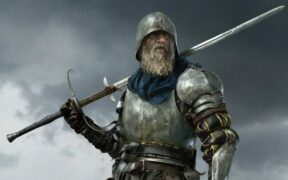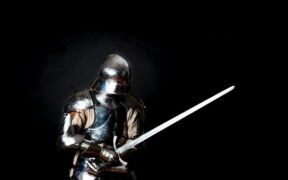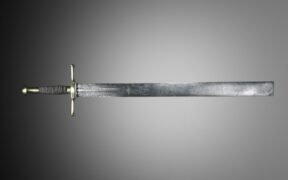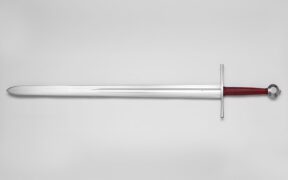Our content features commercial links to our products, committed to transparent, unbiased, and informed editorial recommendations. Learn More
Messer: The Commoner’s Sword of Medieval Germany
NO AI USED This Article has been written and edited by our team with no help of the AI
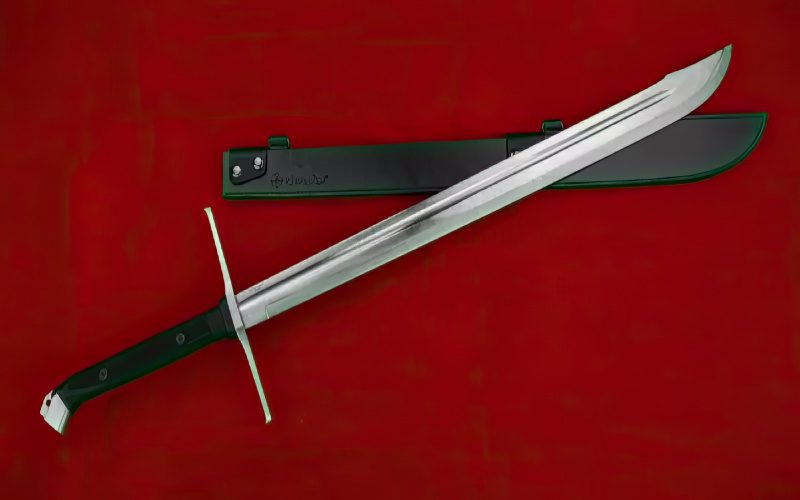
The messer was popular in medieval Germany where commoners carried it as an everyday sidearm. It was essentially a single-edged sword with a knife-like appearance. However, the term applied to a wide variety of swords ranging from one- to two-handed. They were inexpensive weapons of the masses, though not necessarily inferior ones.
Let’s explore the different types of messers, their history, and how they compare to other medieval swords.
Types of Messer Swords
The term messer literally means knife in German, though it refers to a family of cutting blades of varying sizes. While there is no unified typology for these weapons, fencers, and collectors use various terms to describe them.
1. Langes Messer (Long Knife)
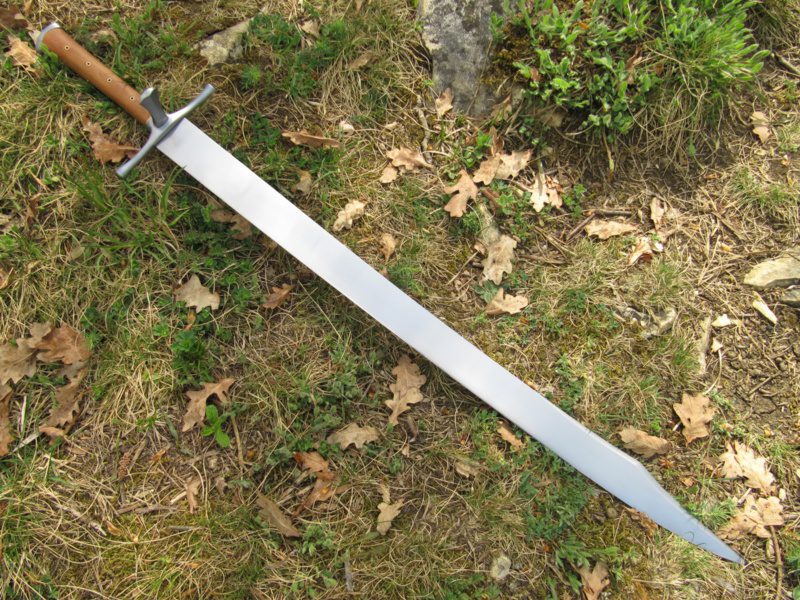
The langes messer was a one-handed weapon capable of making shearing cuts, often efficient enough to slice off a hand from the arm. Having served as a civilian sidearm in medieval Germany, it was also the messer type shown in medieval fight books and used by several fencing masters. In messer fighting, combatants wielded the weapon in one hand with their other hand held behind their back.
2. Kriegsmesser (War Knife)
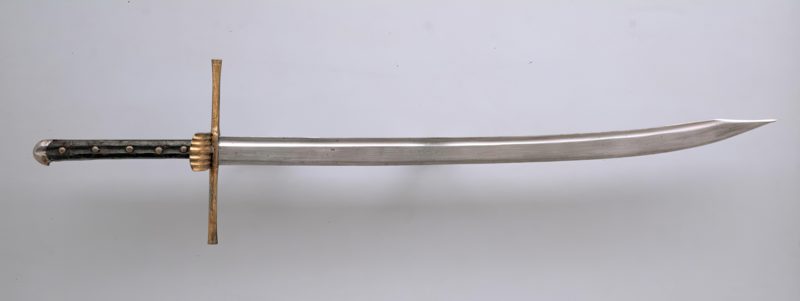
Large enough to use two-handed, the kriegsmessers were among the weapons used by soldiers, as seen in the woodcut series The Triumph of Maximilian by Hans Burgkmair. These two-handed single-edged swords seem to have been part of the weaponry of the Imperial Guard in Vienna under Holy Roman emperors Frederick III and Maximilian I.
Characteristics of the Messer Sword
Messers have a knife-like structure but they are sword-like in size. They are distinguished for their nagel (nail in German), though their blade forms and grip length varies.
Here are the unique characteristics of the messer:
Metal and Construction
Although the messer was plain and inexpensive, it was an effective weapon. Many were manufactured from a single wrought iron billet and the edges hardened by carburization. It was not the best of its time, but its performance as a sword was comparable to those used by professional soldiers and men-at-arms. Some also had quality craftsmanship based on the expected standards of the time.
Today, many replicas and battle-ready swords have full tang and high carbon steel blades with razor-sharp edges. In HEMA, historical fencers use the langes messer sword equipped with flexible blades that bend when thrusted. Some also prefer synthetic-bladed ones which are safer than steel. On the other hand, LARP versions have durable foam blades for safety.
Blade Appearance
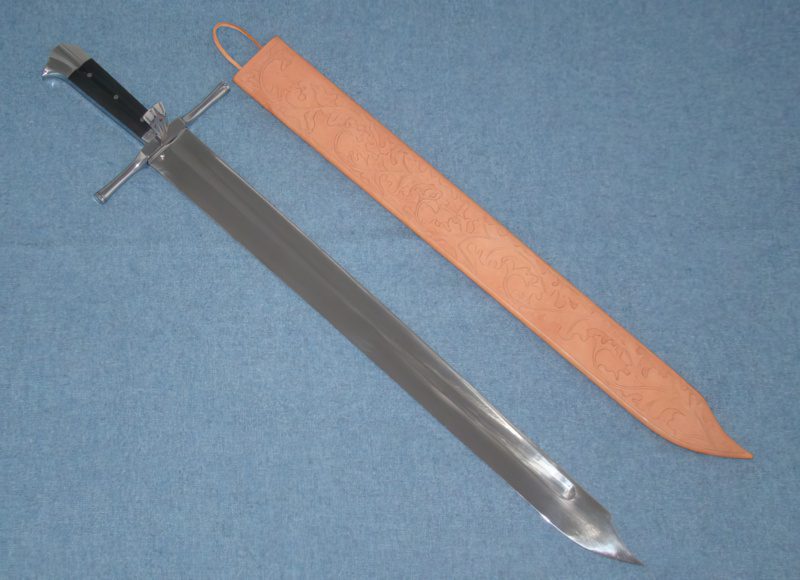
The messer had a single-edged blade, often slightly curved or straight. The langes messer (long knife) typically had a short blade with a sharpened false edge, similar to a knife. On the other hand, the kriegsmesser (war knife) had a longer blade which can be straight or slightly curved, resembling a saber.
Size and Weight
The langes messer (long knife) usually had a blade length of around 60 to 76 centimeters (24 to 30 inches). Some surviving examples had a blade width ranging from 4 to 5 centimeters. On the other hand, kriegmesser likely had blades over 90 centimeters (35 inches) long. The former weighed around 2 to 3 pounds, and the latter about 3 pounds.
Sword Mounting
The messer is recognized for the knife-like construction of its hilt and a small lug on the crossguard.
Grip
Constructed similarly to a knife, the grip of the messer was made from two pieces of wood with the tang sandwiched between them. While the langes messer had a one-handed grip, a kriegsmesser had a grip long enough to use with two hands. Both also lacked a massive pommel to counterbalance the weight of the blade.
Crossguard
Most messers had simple crossguards with a small lug called nagel (nail) that protected the hand, though some versions also have knuckle guards or a recurved quillon on the hilt. The nagel is the distinctive feature of the messer, often shaped like a tongue, mushroom, or decorated shell.
Scabbard
Like other medieval swords, messers often had scabbards with a mouthpiece and chape—a protective metal fitting at the end of the scabbard.
Lange Messer vs. Arming Sword
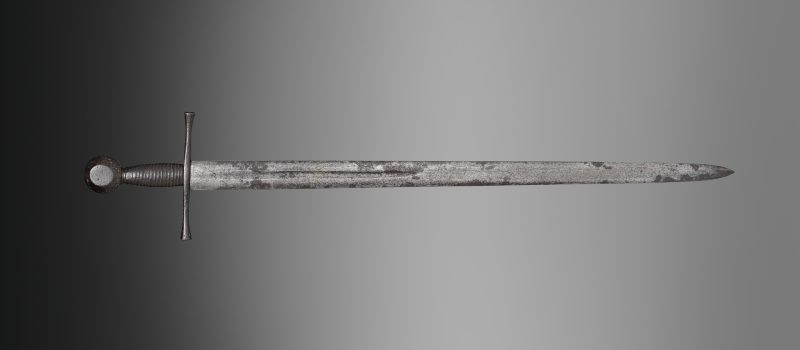
Both lange messer and arming sword had a one-handed grip, but the latter had a pommel that counterbalanced the weight of the blade. Unlike the single-edged messer, the arming sword had a straight, double-edged blade.
The arming sword, also called the knightly sword, had symbolic value. On the contrary, the messer had a modest origin and functioned as a plain sidearm. Still, the messer was not necessarily an inferior weapon.
Lange Messer vs. Falchion
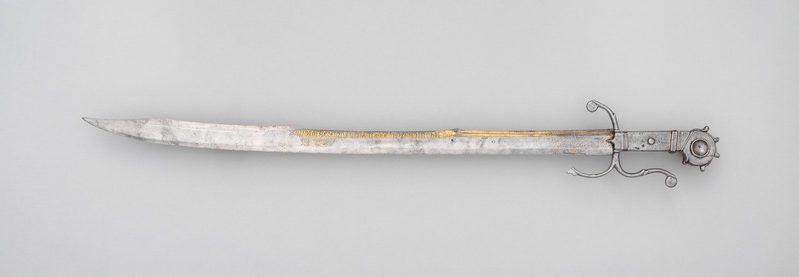
Both lange messer and falchion had single-edged blades, efficient for slashing. However, the latter lacked a nagel on its guard and had a handle constructed like most typical swords. Also, earlier falchions had machete-like blades while later ones had saber-like blades with a sharpened false edge.
Generally, messers were utilitarian in design without a massive pommel while falchions often had pommels decorated with heraldic symbols and other patterns. Also, the falchion served as a symbol of tenure and a token of a grant while the messer was solely a weapon—not a status symbol.
Lange Messer vs. Longsword
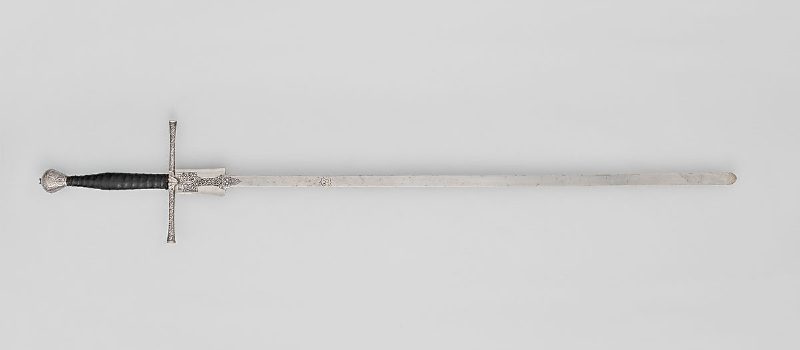
The lange messer was a single-handed weapon, while a longsword had a long grip that allowed the use of one or two hands. The former was single-edged and varied in blade shapes, while the latter always had a straight, double-edged blade.
The lange messer had a shorter blade than a longsword, making it more maneuverable in close-quarters combat. Also, longswords were considered military weapons designed for the elite and professional soldiers. On the other hand, lange messers were more associated with commoners.
Kriegsmesser vs. Longsword
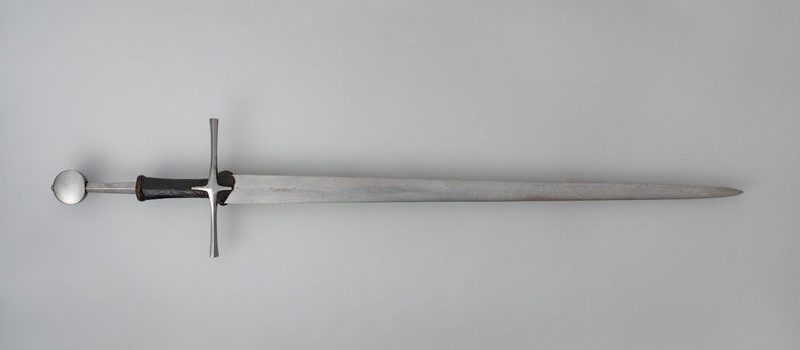
The kriegsmesser was used with one or two hands, similar to a longsword. However, there are no known surviving treatises about the use of the larger messer variation. Many practitioners utilize longsword techniques, particularly the Italian longsword style of Fiore de Liberi and some one-handed messer techniques of Johannes Lecküchner.
Historical Facts About the Messer Sword
From the late 14th to the early 16th centuries, the messer became popular in German speaking-areas of Europe and the regions under their influence. It was often associated with the commoners or with foot soldiers.
The messer was an inexpensive yet effective weapon.
The messer was usually made by craftsmen belonging to a knifemaker’s guild instead of swordsmiths. Its single-edged blade required less time to construct compared to a double-edged sword. Also, lange messers were short enough to be mass-produced at a cheaper cost. However, its performance as a weapon would not have been inferior to swords used by professional soldiers.
Commoners who used the messer may not have had any training.
Fencing manuals on messer combat instruct dealing with a peasant’s strike, suggesting that the most likely encounter with the weapon would be in the hands of a commoner. The German fencing manual Glasgow Fechtbuch also teaches the use of a messer as a self-defense weapon.
Several hunting swords of Emperor Maximilian I were messers.
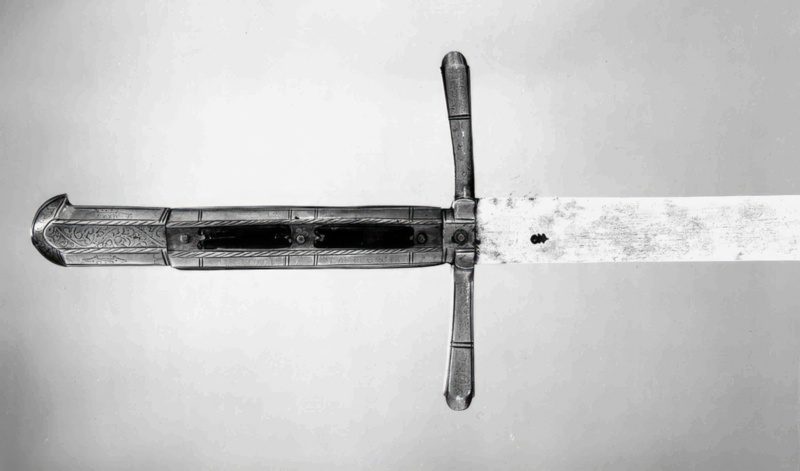
While the messer was associated with commoners, noblemen also owned the weapon. Many hunting swords that belonged to the Holy Roman emperor Maximilian I were of the messer type. Some believed that nobles used them for hunting, so they were called jagdschwerter (hunting swords). Recently, they have been named grosse messer (great knife), as it is uncertain if they were really used for boar hunting.
The use of langes messer was taught by famous fencing masters.
In fight books, the term messer often refers to the langes messer (long knife). German fencing master Johannes Lecküchner produced the most detailed manuals about these long knives. Many fencing masters of the Liechtenauer tradition, including Hans Talhoffer, Paulus Kal, and Joachim Meyer, also taught the use of langes messer.
A messer fencer utilized the nagel to trap an opponent’s blade.
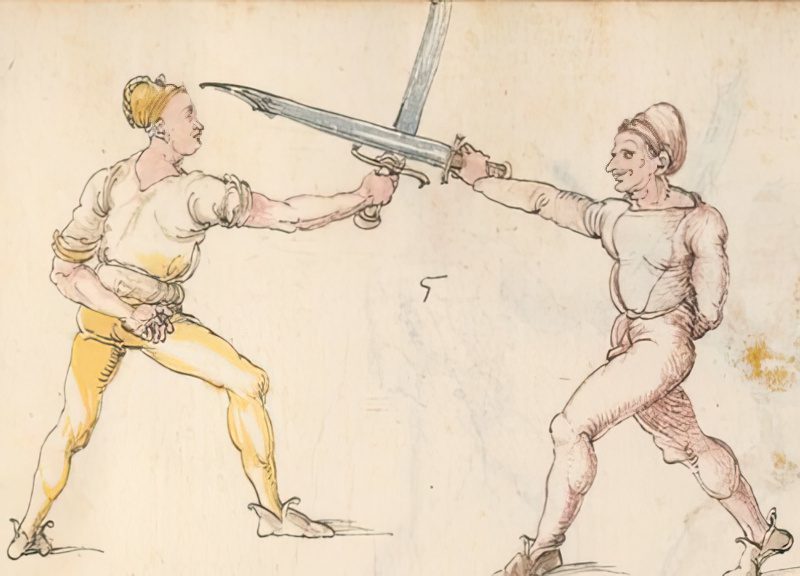
Apart from protecting the hand, the nagel (nail) allowed the fencer to perform various defensive techniques. Fencers could catch the opponent’s strike on the nagel the same way as quillons on a typical crossguard. Others could also parry on it and push the opponent’s weapon away. The messer was also efficient against other weapons, such as daggers, longswords, and polearms.
Messer fighting consisted of techniques for attacking an opponent’s limbs.
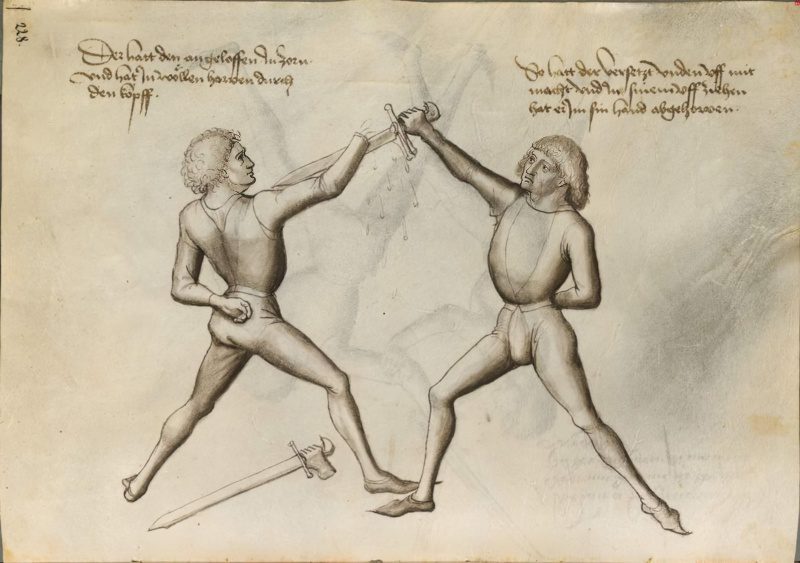
Messer combat involved basic and complex techniques, from swinging a heavy blade to attacking an opponent’s limbs. In Hans Talhoffer’s representation of the messer combat, the hand was cut off by the weapon, which explained the need of gauntlets for practice. Also, fencers placed their left hand behind their back.
Messer plays involved lots of grappling and wrestling.
Messer fencing sometimes utilized a buckler, though most treatises featured the fencer with an unaccompanied messer. In this case, the fencer used his free hand to grapple the opponent or his weapon. Generally, short swords like messers allowed more grappling techniques compared to longer weapons.
The Messer in Modern Times
In Historical European Martial Arts (HEMA), messer fighting is among the sword fighting styles studied by practitioners. In learning langes messer combat, practitioners train with practice swords and wooden swords called dusack.
Generally, one-handed messer fencing is related to fencing with military sabers. Some HEMA practitioners also learn sword fighting with the kriegsmesser. There are no known surviving documents about the specific use of the larger messer variant, so many utilize longsword techniques.
Conclusion
The messer was a popular civilian weapon in medieval Germany, carried when traveling or about town. It was an inexpensive weapon though not necessarily an inferior one. Unlike the double-edged medieval swords, messers remain relatively unknown. Today, they remain relevant among HEMA practitioners and collectors.
